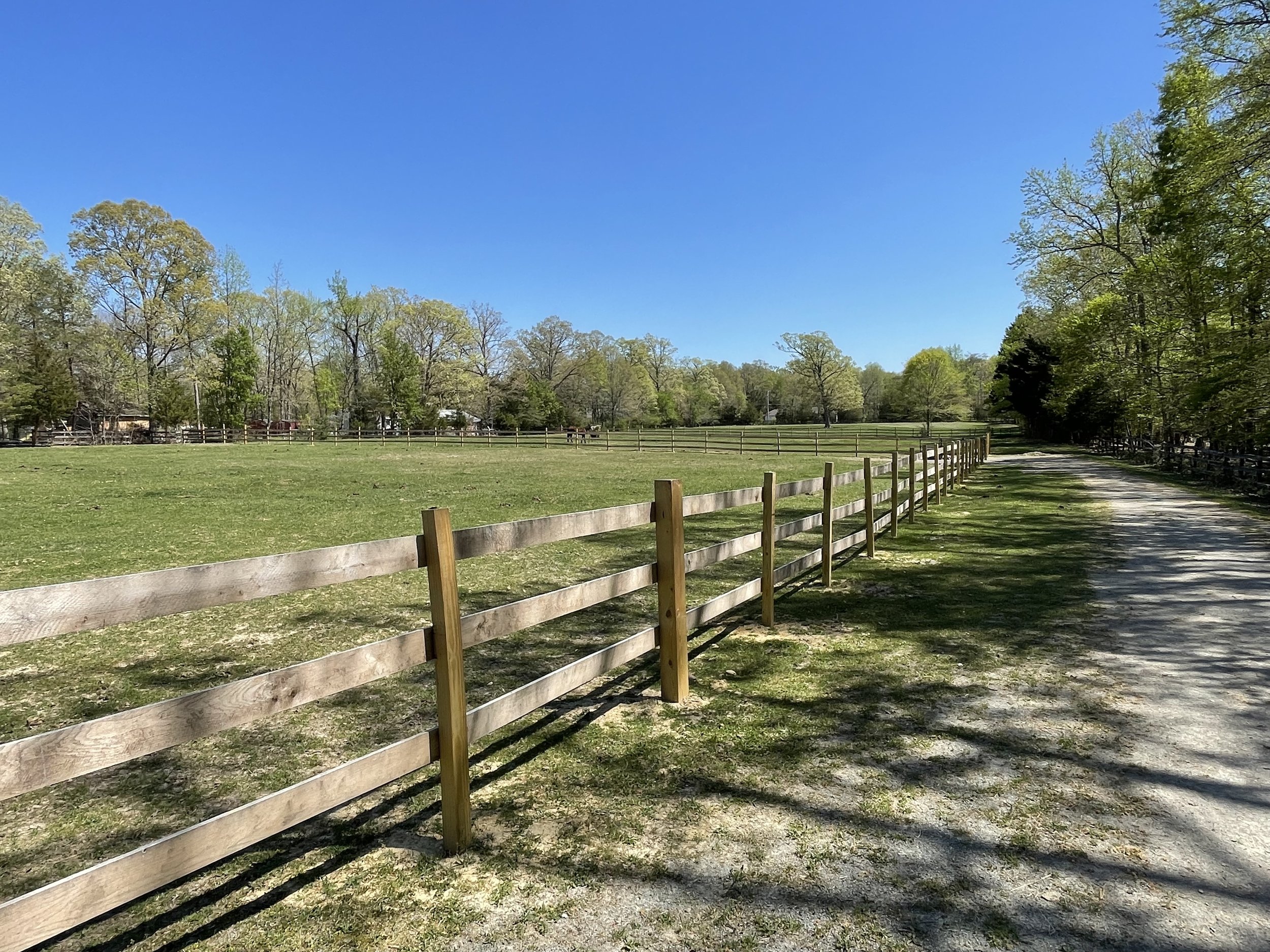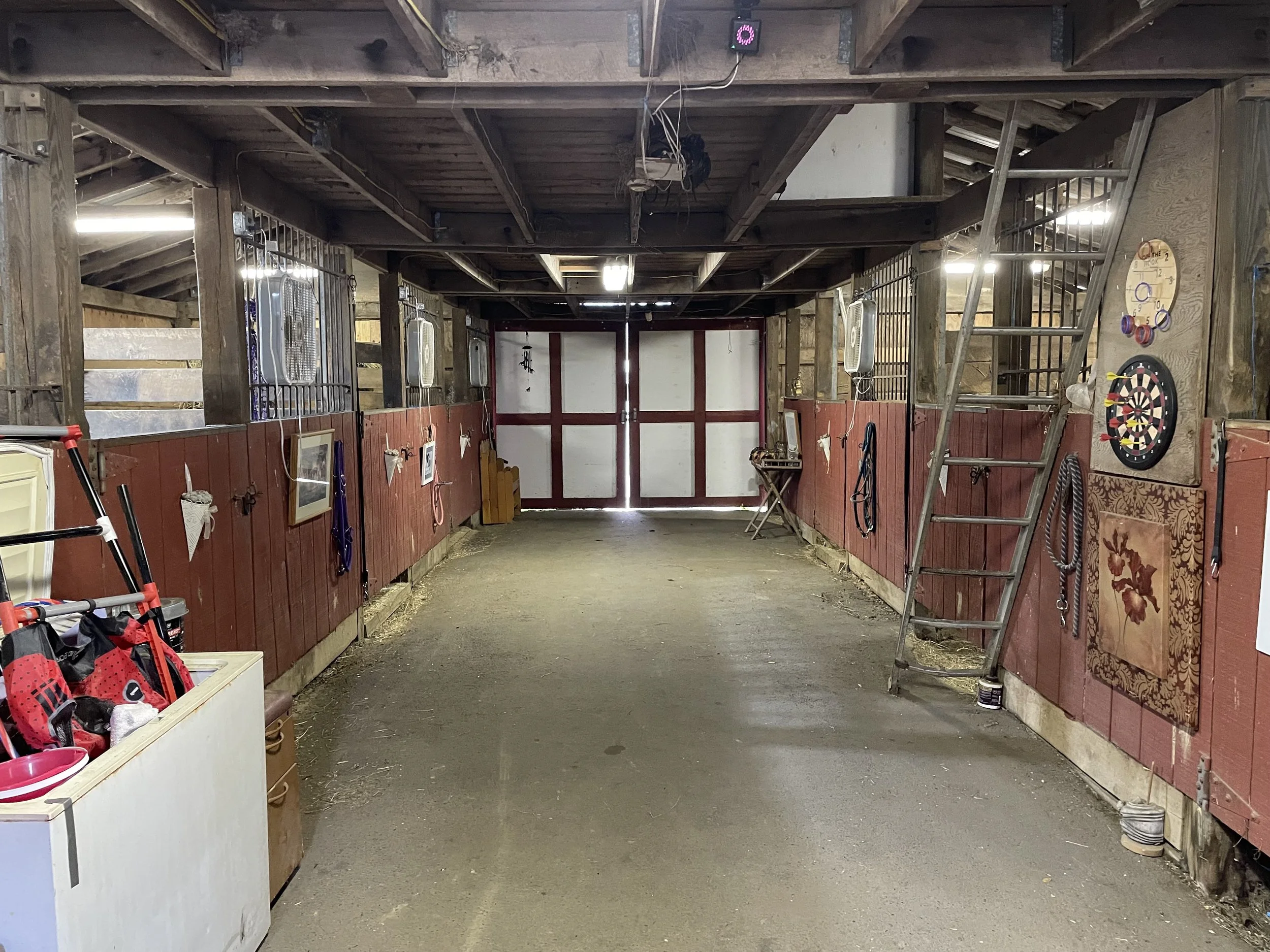A bucolic horse farm in Accokeek
About Hossin’ Around Stables
We hope that our approach to self-care board, however imperfect, will provide our boarders with an environment free of undue stress when they come to care for their horses. We greatly enjoy sharing our bucolic horse farm with like minded boarders.
We aim to divide our up-to 8 horses into 2-3 herds. Accordingly, potential max herd sizes are 4-4-0, 5-3-0, 3-3-2 or 4-2-2. (No horse will be kept solo except in quarantine, for herd introduction or for a failed trial, described below.) Each herd is kept together for turn-outs, whether to paddocks or to assigned dry lots. And each herd is cared for only by their owner(s), as follows: 1) Owner(s) may choose to take care of only their horse(s); 2) Owner(s) may schedule shared care of their horses with other owner(s) of their herd. However, any request for fill-in help i.e., last minute or emergency, for any herd can be provided by any boarder.
While we could have 8 horses and 8 boarders who get along famously for a long time, we think our approach of limiting horse-related interactions to the horse owners within a herd is prudent for mitigating drama.
Only Self-care Board
Following illustrations depend on availability. (Existing boarders will not be compelled to move their horse(s) from their stall, barn or dry lot.)
If boarding 4-5 horses, exclusive uses of one barn, adjacent dry lot, and stall waste compost bins. Your barn, your dry lot, no other horse in your herd.
If boarding 3 horses, non-exclusive use of a dry lot adjacent to your shared barn, and adjacent stall waste compost bins.
If boarding 2 horses, exclusive use of the third dry lot or non-exclusive use of the dry lot adjacent to your shared barn, and adjacent stall waste compost bins.
If boarding 1 horse, non-exclusive use of the dry lot adjacent to your shared barn or the third dry lot, and adjacent stall waste compost bins.
Herd Integration and Trial Period
A new horse is placed solo adjacent to a herd to ascertain likely compatibility. Process might repeat with other available herds. The new horse is integrated into a herd upon unanimous consent of that herd’s horse owners.
However, in the rare instance when no horse owner in any available herd will accept the new horse, or at the sole discretion of the barn owner, if the new horse is deemed incompatible with any available herd within 30 days of boarding, that horse must be removed from the farm within 45 days of written notice. Until then, the horse will be placed solo in an available dry lot or an available paddock near other horses.
Horses paired for one year or longer will not be separated except by their owner(s).
Dry Lots
The dry lots adjacent to either barn can each hold a round bale feeder or a Hay Hut plus 6 or more horses (at 500 sf/horse). But, likely, each of these dry lots will have 4 or fewer horses except if one boarder brings 5 horses. The third dry lot is long and skinny, about 400’ X 16-30’. It holds a square bale feeder and will have 2 horses. All three dry lots have access to shared automatic drinkers.
Horses are moved to dry lots when paddocks are excessively wet. Or, when the shortest grasses in a paddock in use is 4” or shorter and no fresh paddock is available.
Rotational Grazing
Rotational grazing requires moving horses to a fresh paddock when forage need to regenerate. Overgrazing weakens their ability to do that, potentially replacing them over time with unpalatable weeds and such. We practice rotational grazing for these reasons.
Additionally, we test the soil regularly and apply recommended lime and fertilizers. We periodically top dress selected paddocks with our compost.
We now have only cool season forage but will likely introduce warm season forage into a few of our paddocks in the near future.
Our 12 acres of pastures are fenced into 11 paddocks, 10 with shared automatic drinkers.
Two Stables
Originally. the two stables had 22 stalls combined. They now have 5 and 6 matted stalls, respectively. The remaining stalls have been converted for storage, including for hay and shavings. One barn has a hot/cold wash stall. Another barn has a tack/storage room with a keyless lock.
Each barn has nearby stall waste bins for passive aerated composting.
Other
60’ Round pen. No arena or trail access. Horse trailer parking available.
[Updated photos to be published soon.]
Passive horse manure composting bins plus a curing area behind the “big barn.”
Former 1/3 mile oval harness race track divided into three fenced paddocks, and a large pasture fenced into two paddocks. Our 11 fenced paddocks and three dry lots provide more turnout options and improve our rotational grazing practice.
Shared automatic drinkers provide water for our paddocks and dry lots. Yard hydrants have also been placed near the drinkers.
All stalls have rubber stall mats on top of stone dust base. We are replacing fluorescent lights in both stables, when they fail, with daylight color LED fixtures.
Please text or email
your inquiries to
Joseph J Lee, Owner
202.288.5298 jsphjlee@gmail.com
Hossin’ Around Stables
16311 Accolawn Rd
Accokeek, MD 20607
We strive for continuous improvements
by listening
and being receptive to change
that could enhance
horse safety or welfare and
boarder satisfaction










